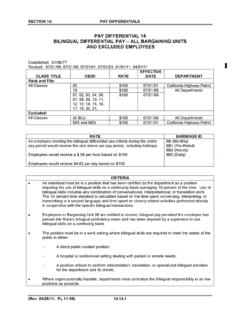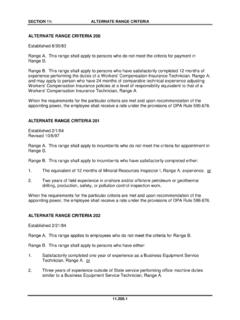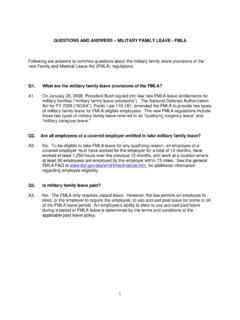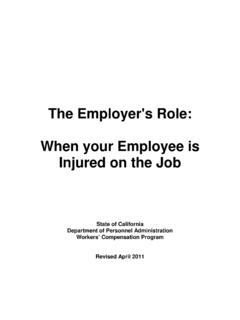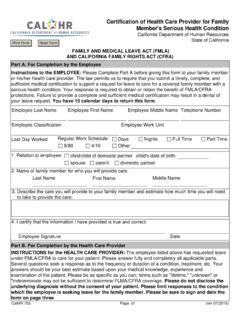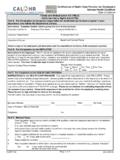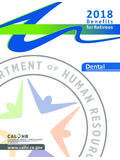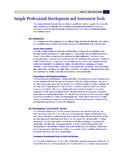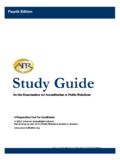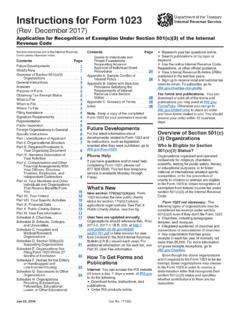Transcription of TO: Personnel Management Liaisons (PML) - California
1 Department of Human Resources Memorandum TO: Personnel Management Liaisons (PML). SUBJECT: REFERENCE NUMBER: Best Hiring Practices 2014-020. DATE ISSUED: SUPERSEDES: 08/18/14. This memorandum should be forwarded to: Personnel Officers Personnel Transactions Supervisors Employee Relations Officers Equal Employment Opportunity Officers FROM: Department of Human Resources Personnel Management Division CONTACT: Personnel Management Division This Policy Memorandum sets forth best hiring practices designed to ensure that departments select the most qualified candidates following a fair and rigorous hiring process. This guidance provides an overview of the hiring process with links to informational resources and tools to assist hiring authorities in every phase of the process.
2 In concert with this policy, the California Department of Human Resources (CalHR) has training available and listed on the current fiscal year training calendar that provides more detailed direction and resources in an interactive setting. Throughout the hiring process, departments should work closely with their respective Human Resources Office (HR), Equal Employment Opportunity Office (EEO) and legal offices to ensure compliance with applicable laws and rules, internal department processes, and provisions of relevant bargaining contracts. I. Duty Statement Creating the duty statement is the first critical step of any hiring process. The hiring authority must prepare a detailed and accurate duty statement for the vacant position for which it is hiring.
3 An accurate and thorough duty statement provides potential candidates with a clear description of the position, and also identifies essential and non-essential tasks and duties that are consistent with and appropriate for the classification specification. CalHR has developed the Virtual Help Desk for Supervisors and Managers, which provides detailed guidance about how to create an accurate duty statement. Duty statements are critical because they identify the position qualifications, additional desirable qualifications, working conditions, and the reporting relationships. Even after the hiring process is complete, supervisors are responsible for maintaining accurate and up-to-date duty statements for each position.
4 An accurate duty statement is also the hiring authority's first opportunity to establish the business justification for a background check, drug testing, credit STATE OF California . PML 2014-020. August 18, 2014. Page 2. check, or more extensive interviews that may be required. For example, because law enforcement positions often involve work of a very sensitive nature and securing the safety of others, almost all law enforcement positions will require some form of background check. Therefore, it is critical that duty statements for law enforcement positions clearly identify the sensitive and safety related tasks that establish justification for conducting a background check. Best Practice: Create a duty statement which provides a clear description of the position and identifies essential and non-essential tasks consistent with, and appropriate for, the classification specification [see the Department of Rehabilitation's Employment Today presentation on Duty Statements].
5 II. Advertisement Positions are generally advertised for a minimum of 10 working days on CalHR's website through a Job Opportunity Bulletin (JOB). Departments may also advertise their positions on their internal and external websites. The 10-day minimum is consistent with the 10-day requirement for posting of examination bulletins as found in the Merit Selection Manual Section 3300. The JOB should include a description of the duties, working conditions, desirable qualifications, and any other job related information. For example, if the position requires a background check it must be referenced in the JOB. Providing all the relevant information regarding the position in the JOB will assist candidates in determining whether they meet the minimum qualifications, and if they are able to perform the duties with or without reasonable accommodation.
6 Best Practice: Advertise vacant positions for 10 working days and include, at a minimum, a description of the duties, working conditions, desirable qualifications, and any other job related information. III. Application Screening Process Departments may direct applicants to submit the application either to HR or to the hiring supervisor. Regardless of who receives the application first, both HR and the hiring supervisor play a critical role in the screening process and should work collaboratively to review the application to ensure that the applicant has the necessary education, work experience, and licenses or certificates required for the position. Before applications are reviewed, the hiring supervisor should develop job related screening criteria that directly relate to the minimum qualifications and the duties of the position.
7 In addition, HR reviews the application to ensure the candidate has list, transfer, or some other form of eligibility for appointment to the position. HR is ultimately responsible for determining if the applicant meets the minimum qualifications for the position and has eligibility for appointment. In some cases, HR will need to request additional information, which may include documents, to determine if the candidate meets the minimum qualifications and has eligibility. HR will also inform the hiring supervisor if an applicant must be given priority due to SROA/Surplus eligibility in the hiring process. The California State Restriction of Appointments (SROA) Policy and Procedures can be found on CalHR's website.
8 STATE OF California . PML 2014-020. August 18, 2014. Page 3. Both the hiring supervisor and HR are responsible for reviewing applicable bargaining unit contracts to ensure compliance with any provisions that may govern the hiring process such as post and bid, seniority, or other terms that relate to filling vacancies. Best Practice: Clearly identify HR and supervisor roles and responsibilities in the screening process. Develop job related screening criteria that directly relate to the minimum requirements and the duties of the position. Review the application to determine if the candidate meets the minimum qualifications for the position and has eligibility for appointment. A. Application Screening Criteria Developing screening criteria is another critical part of the hiring process.
9 Hiring authorities should identify and document job related knowledge, skills and abilities (KSAs) and use them as a basis for developing the screening criteria. For example, if the position requires editing skills and attention to detail, the hiring authority might consider making the existence of significant typographical errors or missing information in the application or the cover letter one of the screening criteria. In contrast, it would not be appropriate to establish screening criteria requiring an applicant to have knowledge of accounting if the essential functions of the position do not involve accounting duties. Screening criteria must be based on job qualifications that relate to the vacant position.
10 Once the screening criteria are developed, the hiring authority should use those criteria to identify the most qualified candidates to interview. Screening criteria should directly link to the KSAs. Information and a sample candidate screening matrix can be found on Page 4 of the Selection Process Module from the Virtual Help Desk for Supervisors and Managers. Screening criteria may be modified after the initial review of the applications if the hiring authority determines that none of the applicants possess the initial desirable qualifications. For example, if a department is looking for a candidate who possesses specialized technology experience and none of the candidates has this background, it would be appropriate to modify the screening criteria to include a comparable job related area of expertise.

